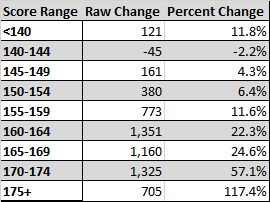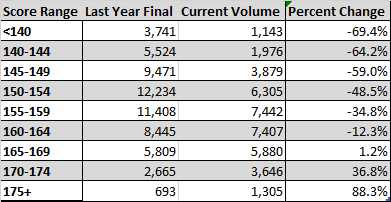Today is coincidentally the last day before January LSAT data comes out, and the day we can see cycle volume through February 1st. We're well into the application cycle now, so let's take a brief look at how things stand.
As of 2/1 there is a 20.2% increase in applicants, a 17.9% increase in LSAT applicants, and a 33% increase in applications from the 2019-2020 cycle.

Brief Overview
The good news for applicants is that these numbers all represent significant downswings from earlier in the application cycle. In early November we peaked at a 40% increase in applicants compared to last year. That percentage has steadily eroded. Most of that erosion happened after mid-December, which you can somewhat see here:

The bad news for applicants is that the percentage drops aren't as dramatic when put into raw numbers. The peak difference in total applicants occurred on December 18th, when we had 8,423 more applicants than last year. Today there are 7,112 more applicants than last year. The gap has only narrowed by about 1,300 applicants. And while that's certainly more helpful for applicants than the number going the other way, it's not a tremendous difference and still indicates significantly increased competition.
Law schools continue to reap the benefits of increased applications per applicant — 81 schools have at least 30% more applications than last year, and only 10 schools have seen a decrease compared to last year.

LSAT Data
LSAT applicants remain up significantly, though less than they were. Aside from a very small drop in 140-144 scorers, applicants remain up in all ranges. They are most significantly increased in the higher score ranges, a trend we've been seeing all application cycle.

In fact, we've seen such substantial increases in high scoring applicants that in the 165-169, 170-174, and 175+ ranges we have already exceeded the entirety of last year's applicant volume:

If we didn't get a single additional applicant for the rest of the year, those ranges would still be up. A lot.
Of course, part of this is due to the fact that higher scoring applicants apply earlier. The lower ranges, which today are far behind the end of last cycle, will catch up (though probably not to the same extent as high scoring ranges). For example, at this time last year we had 81% of the final 165-169 applicant volume, and only 58% of the final 155-159 volume.
Still, it's incredible and anomalistic to see the tremendous increases in high scoring LSAT applicants. To put it in perspective, last year there were 29 schools with a 165 or higher entering median LSAT. This year, you could fill the entire entering class (based on last year class sizes) of the top 45 ranked law schools with the 165+ applicants we have already (and there are a lot more still to come). Now that scenario is obviously not going to happen: some of those applicants won't attend this year, some will go to other schools not on that list, etc. But it illustrates the tremendous supply of high scoring applicants there is this year.
It's way too early for this, but the supply of high scorers also has us wondering what summer waitlist movement will look like. Typically waitlist movement starts from the top down, but given the increase in high scoring applicants, we wonder how much top schools will need to draw from their waitlists.
Looking Forward
January 2021 LSAT scores will be released tomorrow, and as usual this will lead to a flood of applicants and applications. This January's test had about 29,000 individuals registered to take it — over 10,000 more than last year's January LSAT. In fact, the January 2021 test had more registrants than the November 2020 test, which is the first time the late-winter test had more registrants than the late fall/early winter test ever. It remains to be seen how many of those test takers are first timers, and how many are retaking to improve their score.
What's interesting about the large increase in January test registrants is that it's such a large change compared to last year. Some of the fall tests saw increased registrants, but not to this degree. And the summer through fall tests cumulatively weren't that different from last year. The 2021 tests seem like they'll be more dramatically increased, however. January, as we noted, is up. February 2021 currently has almost 21,000 registrants, about double February 2020. That number will come down, but it'll still end up as a large increase. April registrants are at over 20,000 with over three weeks left to register (it's almost impossible to compare to last spring's tests, for obvious COVID reasons). We wonder whether recent events have motivated a new group of potential applicants to sign up for the test and jump into the application pool.
Either way, absent some extraordinary change in test-taker patterns, the large increases in January and February test-takers should lead to some significant applicant volume throughout the next couple of months, especially as we approach our first application deadlines. And then there should be a slow but steady decline again that will last the rest of the cycle. In the end we expect applicants to be up between 20-25%.
Conclusion
We recognize this is a stressful cycle (and year) for everyone. Schools are getting a really good sense of their applicant pool by now, which means they'll be able to roll out decisions — or keep rolling them out. If you're disappointed with your results and wondering how to better your chances on waitlists, we have some compiled advice here.
Good luck to all!


.png)




